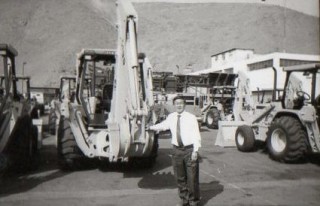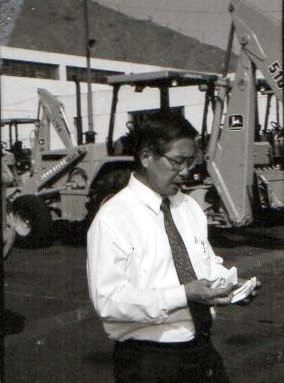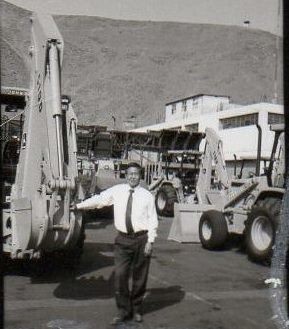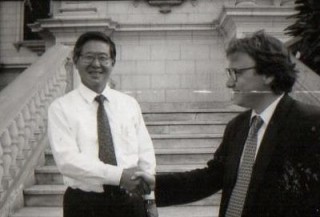Well, thanks to the reminiscences of my colleague Phil Bishop, who looks after our daily news coverage here at The Construction Index, I can tell you.
Phil was clearing out a metaphorical attic the other day and came upon these photos that he took in October 1993 while on a journalistic assignment to South America.
His tour took him across Brazil and Peru at the invitation of Odebrecht, the Brazilian contracting giant, which was engaged in a media relations blitz to put across its side of a corruption scandal. Odebrecht was being accused of paying bribes to win government contracts. (Plus ça change.. and all that.)
Odebrecht countered, rather credibly in Phil’s view, that it had little choice, if it wanted to continue providing employment for its thousands of employees and said that it was effectively the victim of blackmail. A man called Paulo Cesar Farias, who was a close friend of the then president of Brazil, Fernando Collor, ran what was ostensibly a lobbying business. He was also the manager of Collor’s political campaign funds. Odebrecht readily admitted to being one of many companies that paid lobbying fees to the president's mate. This was quite legal. The fact that the money found its way into some kind of political slush fund was not Odebrecht's fault. As far as Odebrecht was concerned, it either had to play the game to rules laid down by others or pack its bags. Collor was impeached for corruption and all the companies that were clients of Paulo Cesar Farias were tainted by association.
Odebrecht could not afford to have its name besmirched; it had only recently made its big move into Europe, taking over George Wimpey’s offshore business in the North Sea and teaming up with Trafalgar House to win the contract to build a bridge over the River Tagus in Lisbon. So Odebrecht invited Phil, who at the time was news editor at New Civil Engineer, to come over to Brazil to see what good guys they really all were. They wined him and dined him, and showed him some of their impressive engineering achievements, including the Chavimochic irrigation project to make fertile 150,000 hectares of desert in northwest Peru.
However, Odebrecht was not the only one with an image problem at that time. So too did the then president of Peru, Alberto Fujimori. He’s the man pictured at the top of this post, and this is where Phil’s trip turned really bizarre.
Part of the programme arranged by Odebrecht for the Peruvian leg of Phil's tour was a briefing with the ministry of trade to learn about opportunities for UK construction contractors in Peru. Somehow, Fujimori got wind of this and decided that briefing foreign journalists was his job. Phil was soon to learn that the Peruvian president was something of a control freak.
And rather than learning about opportunities for UK contractors, he learned instead about Fujimori himself, spending the day in a motorcade driving slowly through shanties with armed secret service agents running alongside the limousines in suits and shades. Fujimori had a referendum coming up and was on the campaign trail. That day, Phil was commandeered to participate in opening three schools in slum areas.
As a Japanese immigrant, Fujimori was very much an outsider in Peru. His politics were populist neo-liberal and he drew his support from the poor and dispossessed; the liberal elite scorned his humble beginnings. They called him ‘El Chino’ and would have been much happier with the famous writer Mario Vargas Llosa, whom Fujimori had defeated in the 1990 presiential election. In Peru Fujimori was sometimes compared to his Russian contemporary, Boris Yeltsin. At this stage he was still broadly considered to be honest but his reputation was on the slide.
His first term of office had brought Fujimori much popularity. He had had significant success countering the terrorist threat posed by the Maoist Shining Path guerillas. He had achieved this in part by building roads into the jungles and mountains where the Shining Path hid out. Road construction was assigned to the army, spreading state power into remote areas.
But as Fujimori’s first term came towards an end, his impatience with the constraints of democracy was becoming apparent. The impending referendum would enable Fujimori to abolish the second chamber of parliament, where he had little support, and empower him to stand for a second term of office. He won the referendum, and subsequent re-election, but after he left office his successor brought criminal charges against him and he was ultimately jailed for abuse of office.
Critics denounced Fujimori as a dictator who had effectively instrumented an ‘auto-coup’ with his constitutional reforms. He was also tried and found guilty of human rights violations against the Shining Path, in Peru’s version of our own Death on the Rock controversy.
Phil says that he witnessed evidence of what might be considered dictatorial, or at least autocratic, behaviour. Fujimori admitted that he decided all policy with little delegation. He seemed to take the view that it was the best way to get things done. He showed Phil a program on his laptop called Vigilia (Watch Out). Essentially it was a spreadsheet that he used to track every command that he had handed down to each minister. His working life was mostly spent chasing up progress on every point. Phil wrote in his subsequent report: He makes 40 or 50 phone calls each day to his ministers, laptop in front of him, checking on progress of projects as mundane as a road improvement scheme. Even the order in which road schemes are executed are decided at the top.
However, the sole reason for all of this reminiscence here is simply an excuse to say something about the collection of construction machinery that Fujimori assembled. He was an agricultural engineer, originally, and his (ex-) wife Susana Higichi was a civil engineer. Before politics, he had been dean of the Faculty of Agriculture in Lima, but he and his wife had made their money in house-building.
Fujimori told Phil that he had spent the equivalent of £50m (£90m in today’s money) on old construction machinery for the army’s road building projects and nothing on weapons.
The president made a diversion between school openings and the return to the palace to show off his equipment depot where more than 100 machines of various ages stood waiting for deployment. Here is some of the inventory, as recorded by Phil:

- John Deere 646G and 510 loaders;
- Caterpillar 814B wheeled dozers;
- and Fiatallis FD143 tracked dozers.
Phil, no expert in these things in my opinion, also noticed some old Lokomo machines and an Ingersoll Rand SD-100D roller.
What’s wrong with British machinery, Phil asked him. Too expensive, came the reply.
There. It took a long way round to get there, but we have finally managed to mention diggers in this Digger Blog post.
Fujimori loved machinery. He would spend his Sundays off refurbishing old motorbikes and scooters. It was his main hobby, he said. He would then donate the finished machines to travelling doctors, to help them get into the shanty towns more easily.
The legacy of all this lingers on to this day. Odebrecht still remains a high profile target for anti-corruption campaigners. In fact, Marcelo Odebrecht was sentenced earlier this year to 19 years in jail for paying bribes to officials of the state-owned oil company, Petrobras. Same old story, it seems.
Meanwhile the Fujimori name lives on in Peruvian politics. Alberto’s 41-year-old daughter Keiko stood for president in June this year and was only narrowly defeated. Phil says he is uncertain whether it was this daughter or her sister Sachi that he saw roller-blading around the stone floors of the president palace, that day in October 1993, complete with Sony Walkman for that full ‘wired-for-sound’ look.
Pictured above are Alberto Fujimori (left) and Phil Bishop at the presidential palace in Lima in October 1993





